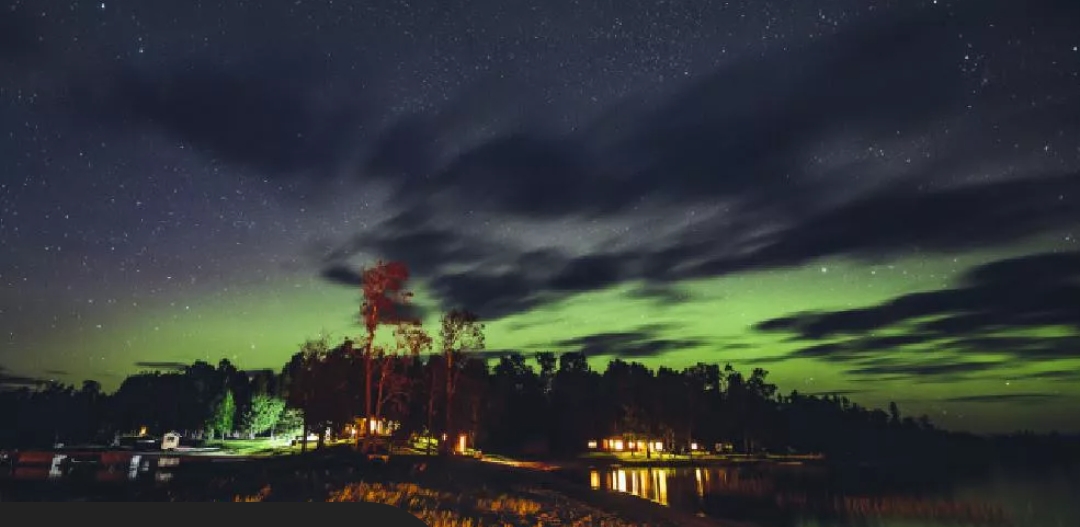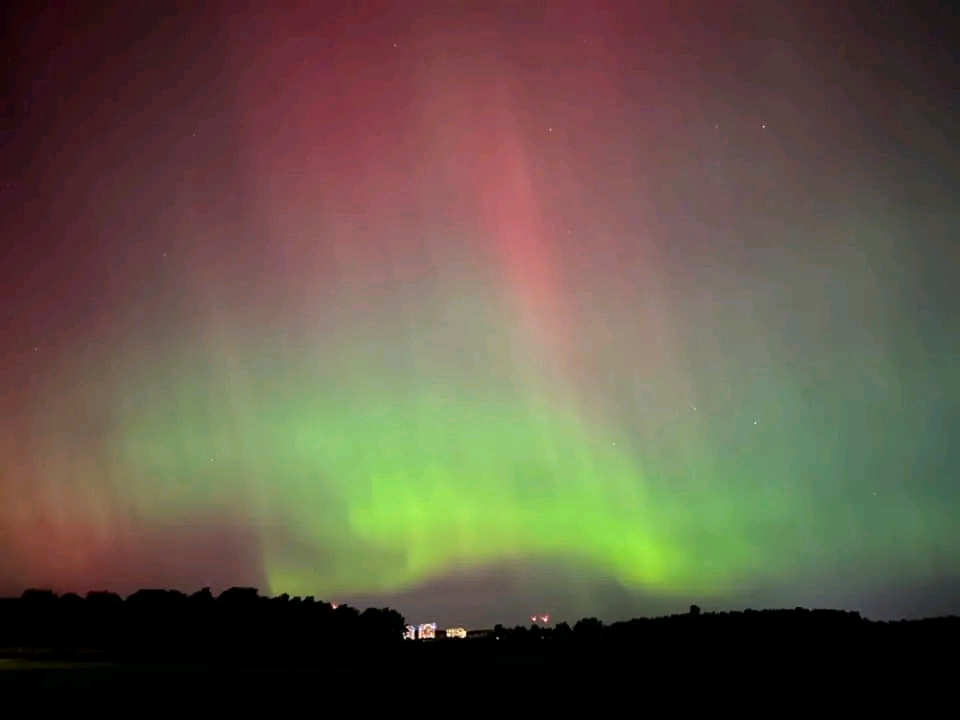Where to see the Northern Lights in Ontario
Green and blue colours of the Northern Lights over a small community in Northern Ontario
Northwestern Ontario
Ontario is home to several designated places and natural parks where stargazers have a great chance of seeing the majestic Northern Lights.
What are the Northern Lights?
Northern Lights are a natural phenomenon of luminous, multi-coloured rays, ripples and curtains of colour that appear to ‘dance’ across the sky. Known as the Aurora Borealis in the northern hemisphere, this light display most commonly occurs in high-latitude regions and is the result of electrical, solar particles colliding with gaseous properties in the Earth’s atmosphere.
When to see the Northern Lights
After reports of solar activity, the best time to see Northern Lights in Ontario is when the sky is darkest, around midnight, and clear of cloud coverage or light pollution (artificial light). You’ll also want to avoid the bright light of a full moon, so choose a night with a waning or new moon. Although the Northern Lights have been reported in every season, winter is often most favourable for viewing, and for stargazing in general, as the cold air contains less moisture than warm summer nights. Astronomers and researchers provide an Aurora Forecast that can help you plan your stargazing expedition.
Tips for viewing the Northern Lights
Besides your tripod, camera, binoculars and perhaps a telescope, consider bringing a reclining camping chair, blankets and a mat for comfort.
Wear seasonal, warm, layered clothing and don’t forget bug spray in the summer.
Avoid the use of bright white flashlights or headlamps for wayfinding. Instead, use red lights which are more conducive to stargazing.
Where to see the Northern Lights
In Ontario, there are eight designated Dark-Sky Preserves, which are natural areas identified by the Royal Astronomical Society of Canada (RASC) that protect the night sky from light pollution and promote sky viewing and astronomy. In addition, many of Ontario’s national parks, provincial parks, conservation areas and wilderness spaces are prime places to witness the Northern Lights.
Point Pelee National Park
Situated at the southernmost point of the Canadian mainland, Point Pelee was designated as a Dark-Sky Preserve (DSP) by the Windsor Centre of the Royal Astronomical Society of Canada (RASC) in 2006 for its commitment to protecting the nighttime environment. On selected Dark-Sky Nights, the park stays open until midnight for optimal stargazing. Bring binoculars or a telescope or even view millions of stars with the naked eye.
Point Farms Provincial Park
Just north of the town of Goderich, Point Farms Provincial Park offers an expansive view of the night sky over Lake Huron. Perched on a bluff overlooking the lake, the park also features a wide sandy beach, perfect for stargazing, viewing planets and catching the Northern Lights. Point Farms is open from May to October, with numerous camping options.
Bruce Peninsula National Park
Located at the northern tip of the Bruce Peninsula near the town of Tobermory, Bruce Peninsula National Park received Dark-Sky Preserve (DSP) status in 2009. The Bruce Peninsula Dark-Sky Preserve is open year-round and offers amazing opportunities to view the night sky over the waters of Georgian Bay. You’ll find a variety of camping options, from backcountry sites to drive-in camping at Cyprus Lake Campground as well as yurt-style accommodations.
Bayside Astronomy
Hosted by the Bruce Peninsula Biosphere Association, Bayside Astronomy is a free public outreach program in the small town of Lion’s Head, on the shores of Georgian Bay about halfway up the Bruce Peninsula. The program brings together amateur astronomers who set up their own telescopes for public viewing. The program typically begins with a star talk at dusk, followed by celestial viewing. When the Northern Lights are visible, this is a great spot to be.
Manitoulin Eco Park
A Royal Astronomical Society of Canada (RASC) designated commercial Dark-Sky Preserve, Manitoulin Eco Park is nestled in a pristine hardwood forest in Tehkummah on Manitoulin Island, just ten minutes from the Chi-Cheemaun Ferry in South Baymouth and about half an hour from the Little Current Swing Bridge.
The preserve provides an open communal field with spectacular 360-degree viewing for stargazing. For those looking for some knowledgeable insight into the night sky and Northern Lights, the Preserve also hosts Stargazing Night Hikes and scheduled Astronomy Nights with various guest speakers.
Emily Provincial Park
Despite being relatively close to the city of Peterborough, the wide-open views of the night sky over Pigeon Lake at Emily Provincial Park are great for stargazing and on occasion, catching the Northern Lights. The Peterborough Astronomy Club hosts public star viewing sessions with guest speakers and telescopes. The park also offers camping and boating on the Trent Severn Waterway.
Charleston Lake Provincial Park
Located on the shores of Charleston Lake about a 45-minute drive from Kingston, Charleston Lake Provincial Park offers an abundance of clear views of the night sky. Beyond dark sky viewing, you’ll find great camping and hiking opportunities, including the nine-kilometre Blue Mountain Trail, up the tallest peak (150 metres) in the county. The park operates from May to October.
North Frontenac Township Dark-Sky Preserve
Known for having the darkest skies in Southern Ontario, North Frontenac Township was Canada’s first municipality to earn “Dark-Sky Preserve” status from the Royal Astronomical Society of Canada (RASC). In addition to exceptional night-sky viewing at the North Frontenac Dark-Sky Pad, the preserve also offers public star viewing through the 16″ Fred Lossing Telescope, free parking, accessible washrooms and electrical service.
Haliburton Forest & Wild Life Reserve
About half an hour drive north of Haliburton, the privately-owned Haliburton Forest and Wild Life Reserve encompasses 100,000 acres of pristine wood and wetlands, with over 100 lakes and countless species of flora and fauna. The reserve offers camping and cabin accommodations, year-round trails for hiking and snowshoeing and spectacular views of the night sky. Learn more about Haliburton Forest’s astronomy program.
Algonquin Provincial Park
Known for thousands of lakes and pristine wilderness Algonquin Provincial Park is also a great spot for stargazing and catching a glimpse of the Northern Lights. Spread out over 7,500 square kilometres of forests, bogs, lakes and rivers, the park provides visitors with countless locations for gaining a wide-open view of the night sky. A variety of backcountry and car camping options are available or book a stay at a nearby retreat, like Northern Edge Algonquin or Killarney Lodge in the park.
Torrance Barrens Dark-Sky Preserve
Spanning almost 2,000 hectares of Crown Land west of Gravenhurst, Torrance Barrens was designated the world’s first permanent dark sky preserve in 1999 and provides an accessible spot for viewing the stars, Milky Way and Northern Lights. The preserve even publishes a Clear Sky Forecast, to help you plan your visit. The prime viewing area is a smooth granite outcrop behind the Ministry sign on Southwood Road. To get there, walk along the main trail, across a boardwalk and up the first ridge. If you plan to camp, book your visit early, as there are only six campsites available.
Note: Between October 17 and November 20, 2024, Muskoka will host 25 free astro-themed events led by expert guides and astronomy enthusiasts. Register now for your chance to experience Muskoka: Home of the Stars.
Killarney Provincial Park
An iconic 645 square kilometre landscape of untouched wilderness, Killarney Provincial Park is also a Royal Astronomical Society of Canada (RASC) designated commercial Dark-Sky Preserve. The park offers a designated area suitable for viewing the starry sky and catching the Northern Lights and meteor showers with the naked eye, binoculars or telescope. In collaboration with York University, Killarney employs a team of Astronomers-in-Residence to deliver engaging astronomical programming. Seasonal camping and year-round, yurt-style accommodations are available.
The Town of Moosonee
For the best chance to view the Northern Lights, go north! One of Ontario’s northernmost communities, the town of Moosonee sits along the Moose River, just under 20 kilometres south of the saltwater coast of James Bay, part of the Hudson Bay Lowlands on the edge of the Arctic. Access is by train or plane, Ontario Northland’s Polar Bear Express offers rail service from Cochrane.
Chapleau Game Preserve
Referred to locally as the “Friendliest Town in the North”, Chapleau is home to the 7,000-square-kilometre Chapleau Game Preserve, the largest crown game preserve in the world. In addition to providing a home for countless species of flora and fauna including eagles, beavers and moose, the Preserve provides incredibly clear views of the night sky with great opportunities to witness the Northern Lights.
Lake Superior Provincial Park
Lake Superior Provincial Park was Ontario’s second provincial park to earn Dark-Sky Preserve status and ranks amongst the darkest of all Dark-Sky Preserves in the world. While stargazing, keep an eye out for nocturnal fauna like bats, beavers and wolves. The park offers diverse camping opportunities, with two serviced campgrounds for RVs and tent camping, plus 200 backcountry campsites open from May to October each year.
Sleeping Giant Provincial Park
East of Thunder Bay, Sleeping Giant Provincial Park features over 100 kilometres of hiking trails through pristine boreal forest on the shores of Lake Superior. By day, the park provides opportunities to view wildlife like deer, lynx and over 200 species of birds. By night, take in magnificent views of the dark sky, along with opportunities to see the Northern Lights. If the Aurora Borealis does make an appearance on your visit, look down at the lake and notice the patterns they cast on the water. With camping available year-round, including full-service cabins, Sleeping Giant should be on your night-sky bucket list.
Quetico Provincial Park
An iconic wilderness park and world-famous destination for backcountry canoeing, Quetico Provincial Park is home to over 2,000 lakes and endless remote wilderness. In 2021, the park was designated as an International Dark-Sky Park by the International Dark-Sky Association. Camping is available in the park all year long, including winter camping and cabin rentals at Dawson Trail campground.
Pukaskwa National Park
Located on the shores of Lake Superior, Pukaskwa National Park offers excellent stargazing and Northern Light viewing opportunities thanks to its remote location. Camping options include drive-in sites at Hattie Cove Campground from May to September, rugged backcountry camping between May and October (weather permitting) and oTENTik sites, a cross between a tent and a rustic cabin, also available May to October. Even outside the park, the Northern Lights have often been seen along the North Shore’s Highway 17 between Sault Ste. Marie and Thunder Bay.
Ontario Provincial Parks
With over 300 provincial parks across the province, there are many more amazing places for stargazing and the opportunity to see the Northern Lights throughout the year. Follow the Ontario Park’s Eyes on the Skies blog each month for stargazing news.
A daily vehicle permit is required for each park you visit. If available, purchase your pass ahead of time and make your camping reservations well in advance. Overall, weekends are much busier than weekdays at Ontario Parks, so plan a mid-week visit. Clean footwear and equipment prevent the spread of invasive species and staying on trails and boardwalks and a zero-litter policy helps reduce the destruction of sensitive habitats.














